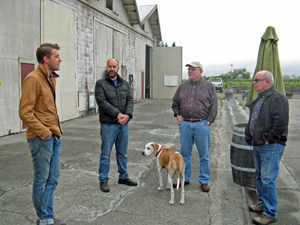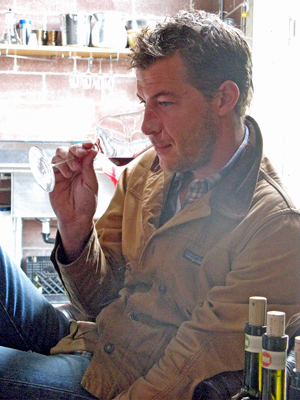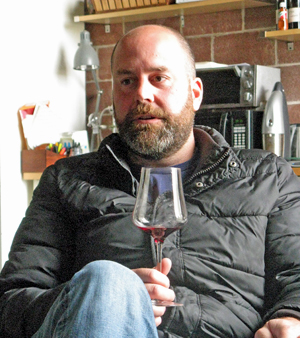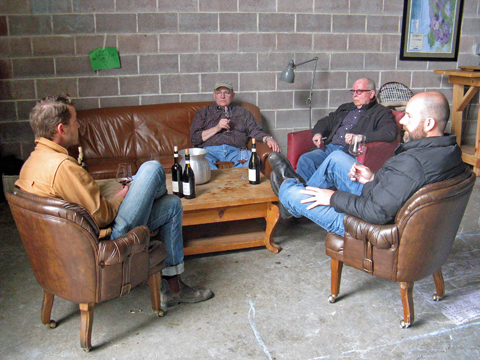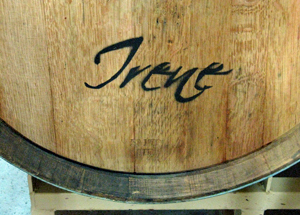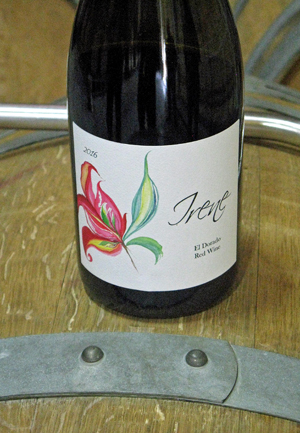Sonoma County Tour - April 2017 - Part 2
Eric, Michael, and I had a good start to our three-day wine tour on Tuesday – a relaxing day with only two winery visits, allowing enough time for us to stop at Russian River Brewing Company in Santa Rosa for a late-afternoon IPA. I had told Eric and Michael that I’d drive on Day 2 of our tour, and I stopped by their hotel just north of Santa Rosa to pick them up. It had rained overnight, and it looked like we might get more rain that morning. I was a few minutes early, but Eric and Michael were ready for me and we killed a little time chatting about some issues that Michael had run into the previous day and evening – pretty humorous, though it might be best not to go into it here! We finally hopped into my car and drove north past Healdsburg to our first wine appointment of the day.
| Wednesday
- April 26, 2017 |
Idlewild Wines and Ryme Cellars
Tasting Notes: Current Releases |
Ryme 2016 Vermentino, “Hers,” Las Brisas Vineyard, Carneros. Very light color, with bright citrus and stone fruit, flowers, and a hint of fresh herbs. Medium-light weight with juicy acidity and a clean, refreshing finish, nice.
Ryme 2015 Vermentino, “His,” Las Brisas Vineyard, Carneros. Light orange color, this featured notes of orangepeel, honey, and spice on the nose. Medium-bodied and very lively on the palate, with a chalky mineral note on the mildly tannic finish – very intriguing and perhaps the best “His” Vermentino yet.
Idlewild 2016 Arneis, Fox Hill Vineyard, Mendocino. Slightly floral, plus stone fruit, orangepeel, and savory aromas. Medium-bodied with good acidity a bit of skin-fermented phenolic character, and a fresh finish, nice.
Idlewild 2015 Cortese, Fox Hill Vineyard, Mendocino. Aromas of fresh herbs, citrus and pear, and a touch of pepper, along with a distinctly saline quality. Medium weight with a bit more texture on the palate and a slight bite of tannin on the finish, nice.
Ryme 2015 Cabernet Franc, Alegría Vineyard, Russian River Valley. Upfront herbal and floral aromatics, with red fruit and earth notes in support. Medium-bodied with a lively mouthfeel, finishing with chewy tannins.
Idlewild 2015 Barbera, Fox Hill Vineyard, Mendocino. Ripe black cherry and plum fruit with touches of smoke and pepper on the nose, and zingy acidity. Medium weight on the palate with a lively finish and moderate tannins.
Idlewild 2014 Nebbiolo, Fox Hill Vineyard, Mendocino (pre-release). Medium-light garnet color, with classic Nebbiolo floral and tarry aromas along with red fruit, earth, and herbs. Medium-bodied with lots of structure and big but refined tannins – Idlewild’s best Nebbiolo yet.
Ryme 2013 Aglianico, Luna Matta Vineyard, Paso Robles. Dark color, with ripe black cherry and darker fruit, lots of spice, herbs, earth, and a savory component. Big and bold on the palate, finishing with grippy but not aggressive tannins – still best to cellar this for a few years but it’s got fine potential.
|
|
Before our Sonoma wine tour, I’d contacted both Sam Bilbro of Idlewild Wines and Ryan Glaab of Ryme Cellars, as they share a winemaking facility and I figured it would be convenient to visit both of them there. I left it to them to coordinate things, and they decided to make it a joint visit and tasting which worked out great – always good to get a “two-fer”! It helps that Sam and Ryan are close friends – they’ve known each other for a number of years and their kids go to school together. I’d first met Sam when we were pouring at adjacent tables at a trade tasting in San Francisco in the spring of 2013, and I met Ryan – and his wife / partner in Ryme, Megan – about a month later at the Seven % Solution wine tasting event in Healdsburg. I was impressed by their wines right away but this visit was the first time I’d spent much time with either Sam or Ryan.
The facility that Sam and Ryan share is located between Healdsburg and Geyserville. A number of winery buildings I’ve been to over the years have been re-purposed from other uses, but this was the first time I’d visited one that had originally been a mushroom farm! Sam and Ryan have been in the facility for about two years, and they also share it with another friend, Leo Hansen of Leo Steen Wines (a Chenin Blanc specialist). The building is a long concrete block structure with a number of separate compartments. Each of the three labels has its own space and there are some shared spaces as well. The three of them share equipment, which helps keep their costs manageable. It’s a plus that all three strive to make their wines in a similar minimal-intervention manner – native ferments, no added water, acid, nutrients, etc. – and also that there is almost no overlap in the wine varieties that each of the three works with.
We followed the directions to the winery that Sam had sent us and parked behind the building. Sam and Ryan came out to welcome us, and we stood outside talking for a few minutes, despite a light drizzle that morning. We headed inside before too long, and took seats at some big comfortable chairs and a sofa in the corner of one of the winery spaces. Sam and Ryan each chose four of their wines to pour for us – two whites and two reds apiece – and they organized them into a single flight rather than grouping them separately by winery, a nice way to do the tasting that emphasized the spirit of cooperation rather than competition between vintners.
A little background on Idlewild and Ryme is in order here, and since Ryme was the first of the two to be established, I’ll start with them. Ryan and Megan both pursued winemaking degrees, and they met while working as seasonal cellar hands at Torbreck Winery in Australia’s Barossa Valley. They founded the Ryme label in 2007 – the winery name comes from the first two letters of their first names. Between the two of them, Ryan and Megan have worked for some highly-regarded producers, including Peay, Sine Qua Non, and Marcassin. Ryan eventually became the assistant winemaker for Pax Mahle’s Wind Gap label, and earlier vintages of the wine were made at the Wind Gap facility. Ryme’s first release, from the 2007 vintage, was from one ton of Aglianico sourced from Luna Matta Vineyard on the Westside of Paso Robles. Finding the fruit came through a personal connection, as Ryan and Luna Matta vineyard manager Stephy Terrizzi had been college roommates – that sort of personal connection in sourcing fruit was a recurring theme throughout our three-day wine tour.
Ryme produces a number of wines, with something of a focus on Italian grape varieties. In addition to the four Ryme wines we tasted on this visit – two Vermentino bottlings, Cabernet Franc, and Aglianico – they make Fiano, Ribolla Gialla, Pinot Noir, Carignane, and Cabernet Sauvignon. Fruit is sourced from sustainable or organically-farmed vineyards, and as mentioned above, the winemaking can best be described as minimal intervention. A number of vinification methods add to the interest of the wines – some whites are fermented on the skins, there’s often lots of whole-cluster fermentation used on the reds, there are long macerations on some wines (up to four months), and some fermentations are done in clay amphorae, while barrels range from 2 to 10 years old. Total current production for Ryme is around 2,000-2,500 cases per year. Ryan also works as a consulting winemaker for several other labels including Petrichor and Lost & Found.
In addition to Ryme, Ryan and Megan have recently launched a new project called Uphold Wines. It’s a way for them to make an increased commitment to supporting social progress and community. Uphold makes affordable everyday wines – a white, rosé, and red - and 100% of net profits go to organizations that uphold "protection of the planet, women's rights and people's equality." The initial white is Vermentino-based, the rosé is from Aglianico, and the red is Carignane. I had the opportunity to taste these first Uphold releases a couple of weeks prior to our visit with Ryan, and they’re all delicious and offer great value.
Sam comes from a winemaking family. He told us that his great-grandfather made wine in Cloverdale during Prohibition and trucked it to San Francisco. Sam’s father Chris started Marietta Cellars in Geyserville in 1978, so Sam grew up around grapevines and winemaking. His brothers are both in the wine business as well – Jake has run the Limerick Lane vineyard and winery since 2011 and Scot now runs Marietta. Sam worked in the restaurant and produce businesses prior to starting Idlewild in 2012. He told us that he liked the word Idlewild and learned it came from the name for a special place that Native Americans felt to be “peaceful but savage” – he thought that was an apt description of Nebbiolo (one of the winery’s specialties) and went with that name for the label. Speaking of labels, Sam designed the Idlewild wine labels, after teaching himself Illustrator so he could do the artwork. A new addition for Idlewild is their salumi and wine bar located just off the Plaza in Healdsburg, opened only a couple of months before our visit to the winery.
Over the years, Sam has been able to try fine wines from all over the world, but he took a special liking to the wines of Piemonte in northern Italy, and the grape varieties found in that region are the focus of Idlewild. The winery produces varietal bottlings of Arneis, Cortese, Dolcetto, Barbera, and Nebbiolo, all sourced from Fox Hill Vineyard in Mendocino County. Other recent varietal releases have included Valdiguié and Carignan. In addition to these varietal Idlewild wines, Sam also makes three blends, collectively known as the “Flora & Fauna” blends. The current “The Bee” white is a blend of Moscato, Arneis, and Cortese, “The Flower” rosé is from Dolcetto, Nebbiolo, and Barbera, and “The Bird” red is a blend of Barbera, Nebbiolo, Dolcetto, Grignolino, and Freisa. I’ve tasted these several times in the past, and they’re always quite nice, and good values too.
Sam told us that he aims to make wines that are true to their Italian origins but are still Californian. Fox Hill Vineyard, the source of nearly all of Sam’s fruit, is located just south of Ukiah. Sam now manages the vineyard, helping to ensure that the fruit is grown in the way he wants. Like Ryan, he ferments using native yeasts and keeps things simple in the winery. Sam told us that he’s not looking to copy winemaking methods of Piemonte – for example, he makes his Arneis in neutral oak rather than stainless steel in order to tone down the fruit component of the wine, and he ferments his Nebbiolo with a substantial percentage of whole clusters. He was excited about getting a large wood fermentation vessel this year. In general, Sam is looking for an energy from his wines, something he referred to as a “loaded spring” quality.
Ryan started out our tasting with two Ryme wines, the 2016 “Hers” and 2015 “His” bottlings of Vermentino. The names of the two bottlings reveal that one is Megan’s preferred style of the wine (bright and aromatic) and the other is Ryan’s (savory and textural) – what a great idea to make wines in both styles! The fruit for both was sourced from Francis Mahoney’s Las Brisas Vineyard in Carneros, and picked at the same time – the only difference is the winemaking method. The “Hers” Vermentino was pressed right away, fermented half in stainless steel and half in barrels, then bottled early after aging in neutral oak. The “His” rendition is in an “orange wine” style, fermented with foot-trod whole clusters like a red wine, spending about two weeks on the skins, then 10 months in neutral barrels. The Ryme Ribolla Gialla is made in a similar way, and Ryan told us that he likes orange wines for their interesting texture combined with freshness. In past years, I’ve always had a preference for the “Hers” Vermentino bottling but this time it was really a toss-up – they were both delicious, but very different.
We continued with the two Idlewild whites, beginning with 2016 Arneis. This was whole-cluster pressed and fermented in stainless steel before going to neutral barrels for about five months. Sam told us that he likes to include harder press wine to add more texture and structure to the Arneis. The 2015 Cortese includes fruit from two separate picks at the vineyard – 75% picked early and direct-pressed to neutral oak, and 25% picked later and skin-fermented, with nearly three months of maceration before pressing. Sam noted that Gavi wine from Piemonte (made from Cortese grapes) used to be known as the “White Burgundy of Italy.” He also mentioned that it’s been a relatively easy grape to work with during harvest season in the vineyard since it retains acidity while gaining sugar slowly. These may be Idlewild’s best renditions of these two white varieties yet.
Moving on to reds, Ryan poured us the Ryme 2015 Cabernet Franc, sourced from Alegría Vineyard on the northern edge of Russian River Valley. The Cab Franc vines were planted there in 1990, and since it’s a cooler site for the variety, Ryan is able to harvest it fairly late and the brix remains on the low side. Fermented with whole clusters, it’s a lighter style of Cabernet Franc. Next up was 2015 Idlewild Barbera. Sam did a whole-cluster fermentation with the fruit, and he said that he does a heavier foot-treading for Barbera than for a more tannic variety such as Dolcetto. In this case, he feels it helps add structure and a more savory note to the wine.
We had plenty of tannin in our final two wines – the Idlewild 2014 Nebbiolo and Ryme 2013 Aglianico. The Idlewild Nebbiolo, which will be released this fall, was fermented with 50% whole clusters (something that’s rarely done in Piemonte) and spent about 90 days on the skins before pressing to neutral oak. Nebbiolo is a notoriously difficult grape variety to master, but Sam is making great strides already considering his first Nebbiolo was from the 2012 vintage. The Ryme Aglianico was entirely whole-cluster fermented, and aged for three years in neutral barrels. Aglianico can be a massively dense and tannic wine, but Ryan described the 2013 vintage as fleshier than some earlier ones, and I agree that it does not seem as tannic as some of the earlier Ryme Aglianicos – this certainly ranks with some of the best I’ve tasted from California.
We had a very relaxing time tasting with Sam and Ryan, one of the most memorable stops during our three-day wine tour. The comfortable and low-key setting helped foster more give-and-take discussion than I’ve had during most visits with vintners, and it helped that this easygoing and straightforward quality seems to be reflected in both Sam’s and Ryan’s personalities as well. We interspersed our tasting with related discussions including various vine trellising systems and the potential benefits of farming for somewhat higher crop loads to help keep brix in check, as well as Ryan’s pointing out how stem tannins can help fill out a wine’s structure, creating broader and less sharp tannins. Tasting the wines from both Idlewild and Ryme together as we did was a good way to compare them, since the winemaking approaches have similarities though there are certainly some differences as well.
Sam and Ryan poured us an outstanding group of wines during our visit. My overall favorites were the whites – both the Ryme 2016 “Hers” and 2015 “His” Vermentinos, and the Idlewild 2016 Arneis and 2015 Cortese. The Idlewild 2014 Nebbiolo and Ryme 2013 Aglianico were close behind. Both Sam and Ryan pursue a similar goal of purity in their wines and I think they both succeed very well. The simplicity of the winemaking methods that they each use helps to bring out that transparent quality, emphasizing grape variety and vineyard source over technique. It was a pleasure to visit Sam and Ryan, and the wines from both Idlewild and Ryme are well worth seeking out – among the best renditions of the grape varieties they work with that you’ll find from California.
We’d checked out several lunch options in Healdsburg on the web prior to our wine tour, and gotten a few more recommendations from Sam, and we decided that beers were in order so we headed to Bear Republic Brewing for lunch. The weather was clearing up by this time, and after finding a parking spot nearby (which wasn’t easy), we headed inside – it’s a fairly large place so we had no problem being seated right away. Bear Republic’s flagship beer is the Racer 5 IPA and they have many other fine brews on tap as well. Our waitress (who called me “sweety”, “honey”, and “darling” on various occasions during our meal!) took our order of a couple of burgers and a BBQ pork sandwich to go with our beers. Wish I could say the food was as good as the beer, but it wasn’t the case. Not that the food was bad, just pretty ordinary. Still, I’d say it was worth it for the fun atmosphere and tasty beer.
We had about an hour before our afternoon wine appointment, but we didn’t really feel like stopping at any of the wine tasting rooms that seem like they’re in every other storefront around the Plaza in Healdsburg these days, so we just took a relaxing walk around town for awhile before heading back to the car. From there, it was a very short drive to our next destination.
Irene Wine Cellars
Tasting Notes: Current Releases & Barrel Samples |
Irene 2016 Marsanne, Alder Springs Vineyard, Mendocino (barrel sample). Ripe stone fruit and citrus aromas, with notes of spice and earth. Medium-bodied with great acidity and a long finish – still developing in the barrel but has potential.
Irene 2016 Red Wine, El Dorado. 80% Mourvèdre, 20% Syrah. Medium-light color, this featured bright red fruit, herbal and earthy notes, with flowers and spice in support. Medium weight with a lively texture and moderate tannins, already nice and should be even better with a bit more time in the bottle.
Irene 2016 Syrah, Fenaughty Vineyard, El Dorado (barrel sample). Dark color, with blackberry, fresh herbs, black olives, and savory, spicy notes. Medium-bodied with fine acidity and a stony mineral quality on the finish – an impressive young Syrah.
Irene 2016 Syrah, Rodnick Farms, Chalone (barrel sample). Interesting aromatics of black olives, flowers, red fruit with citrus undertones, and herbs, and earth. Big and structured, with a chalky mineral character on the chewy tannic finish – intriguing but definitely in need of more time.
|
|
After our mid-day stop at the Plaza in Healdsburg, we drove toward the south end of town and into the Healdsburg Custom Crush facility. It’s a newer operation, launched in 2014. That was no problem for the vintner we were meeting there, as his first commercial release was from the 2015 vintage! Brian Jessen and his wife Katelynn run Irene Wine Cellars, one of Sonoma County’s newest wineries. I met them last fall when they poured next to the Harrington Wines table at the Califermentation tasting at Terroir Natural Wine Bar and Merchant in San Francisco. I liked the wine they poured there, and kept them in mind for the next time I visited Sonoma wine country.
After parking, we located Brian quickly and he led us into one of the buildings at Healdsburg Custom Crush, formerly a self-storage facility. There are about 15 clients currently making wine there. Brian is originally from Monterey County, and he attended the wine business program at Sonoma State University. He found himself interested in other aspects of the wine industry and worked in the cellars and tasting rooms of several wineries while attending school. Brian went on to the Santa Rosa Junior College viticulture and enology program, and also worked in Italy, New Zealand, at Ceritas Wines, and as cellarmaster at Copain Wines. His current dayjob is selling vine cuttings and rootstock to nurseries, and now selling grafted vines as well. He told us that this work meshes well with winemaking since the busiest times of year are different for each.
The winery name is a tribute to Brian’s mother, who passed away when he was young. Their first release was a very nice 2015 Red Wine – a Mourvèdre/Syrah blend from El Dorado. Brian is expecting to increase winery production from that initial 135-case release to about 250 cases from the 2016 vintage, and then to around 500 cases in the future. Katelynn painted the beautiful watercolors for labels, and Brian showed us a preview of the labels for the upcoming 2016 wines, with each bottling featuring a different flower.
Farming for the vineyards that Brian sources from for the Irene wines are all sustainable or organic, and he told us that he makes his picking decisions mainly on acid and texture rather than brix. Reds are all fermented with native yeast, made entirely with whole clusters and foot-trod. Fermentation for reds is done in t-bins, and maceration lasts about 15 days, with fruit from Antle Vineyard getting a few additional days. After pressing, Brian settles the wine in tank before racking to all neutral oak. There are no additions to the wine and no filtering. Brian does the crush work for his wines at the Papapietro Perry / Anthill Farms facility in Dry Creek Valley and moves his barrels to Healdsburg Custom Crush near the end of each year.
Inside the barrel room, Brian’s barrels (all seven of them!) had been moved to be easily-accessible on the floor, and he pulled a barrel sample of 2016 Marsanne for us to taste. The fruit comes from Alder Springs Vineyard in northern Mendocino County. The vineyard has a wide range of different blocks and various elevations and exposures, and although it’s not too far from the coast, the marine influence is limited and coastal fog is not an issue there. The Marsanne was grown on decomposed sandstone and shale soil, and Brian picked it at 20.4 brix. The fruit was destemmed and left on the skins for 24 hours prior to pressing – Brian told us that he’s aiming for both freshness and texture in the wine. The Marsanne has been fermented and aged in neutral oak – it’s still not quite completed with fermentation, though with warmer weather finally returning to Northern California it should finish soon. The wine will stay in barrel for about 11 months.
Brian then opened the recently-bottled 2016 Red Wine. While the 2015 vintage had been 50% each Mourvèdre and Syrah, the 2016 blend is 80% Mourvèdre and 20% Syrah. The vineyard sources for the fruit remain the same, with the Syrah coming from Fenaughty Vineyard and the Mourvèdre from Neighbors Vineyard, both higher-elevation sites northeast of Placerville in El Dorado County. Both vineyards feature mostly volcanic soil over decomposed granite, and the Mourvèdre vines at Neighbors Vineyard are head-trained and closely-spaced. This wine is bottled earlier than the other Irene wines to bring out the freshness in its character.
We followed the bottled wine with two more 2016 barrel samples, both Syrah. The first was from Fenaughty Vineyard – Brian said the site is north-facing, with own-rooted 35-year old vines. He’s planning to bottle this wine in July and it’s already showing lots of promise. Our last wine was a barrel sample of 2016 Rodnick Farms Syrah – this will be the new name for Antle Vineyard, in the Chalone AVA. Located at about 1,700-foot elevation, this has limestone and volcanic soil, and 25-year old vines sourced from Joseph Phelps Vineyard (sometimes referred to as Joseph Phelps clone). Brian noted that the fruit clusters there have very small berries. The Syrah was picked 21.7 brix and co-fermented with about 50 pounds of Viognier from the same vineyard.
It’s always exciting to see a new label such as Irene get off to a promising start. Over the years I’ve sometimes been overly-optimistic about new producers, but I feel in this case that optimism is warranted. The potential that was shown by the inaugural Irene 2015 Mourvèdre/Syrah release looks like it is being followed up very well by Brian’s 2016 Irene wines. It certainly helps that he is working with fruit from highly-regarded vineyards such as Alder Springs, Fenaughty, and Antle/Rodnick Farms. I thought the bottled 2016 Red Wine blend was already showing very well, and among the barrel samples, the 2016 Fenaughty Vineyard was a standout. Brian is a quiet and thoughtful guy, and his methods reflect that – he keeps things simple, with wines on the “natural” side of the spectrum and an overall style that I’d describe as clean and fresh. It should be fun to follow the Irene label in the coming years.
I dropped off Eric and Michael at their hotel and drove back to my place, and we all relaxed for awhile before dinner. Eric had made our Wednesday dinner reservation at Riviera, which happened to be located in the same small commercial complex in Santa Rosa as Rosso, where we’d had dinner the previous evening. Informal but with a bit more of an upscale atmosphere than Rosso, Riviera is more of a classic Italian-American restaurant, with a broader menu than at Rosso. The caesar salad at Riviera was more what I expected than the one I’d had the previous evening, and the entrée I ordered – homemade organic kale and spinach ravioli with braised leg of lamb – was delicious. Prices were very reasonable for the quality of food, and the wine list featured a good selection of wines from both Italy and Sonoma County. I’d definitely consider dinner at Riviera again.
|


